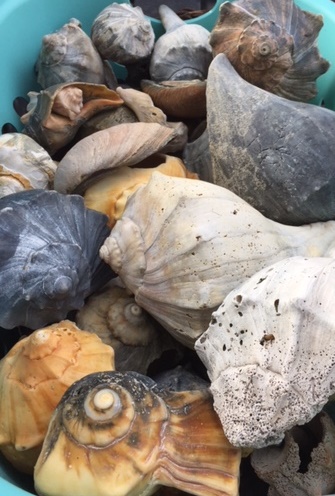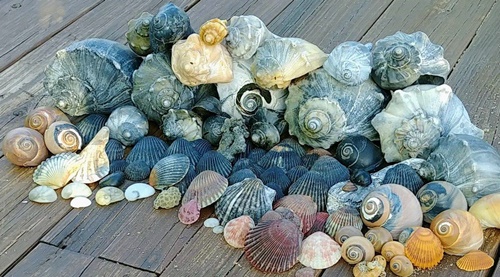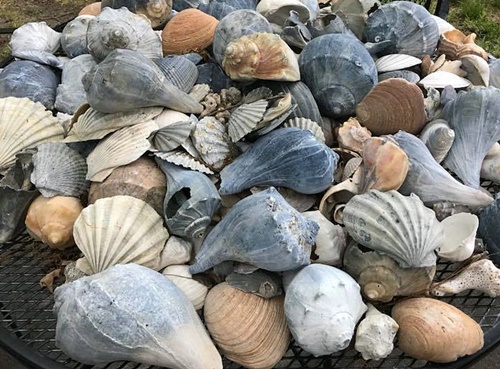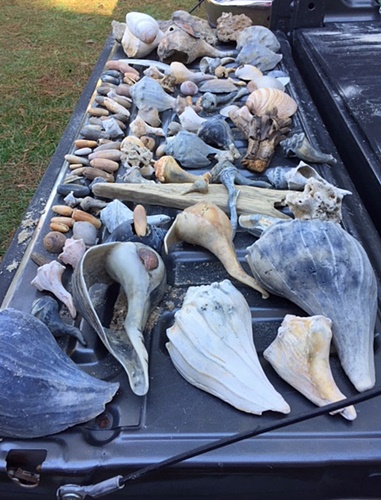Hey fellow shell hunters! Are you ready to dive into the fun of Outer Banks shelling? Today, let’s talk about the incredible variety of seashells you can find along the stunning North Carolina coast! Our coast has many different types of seashells that wash up on the shore. Beachcombing is in-season all year round. It’s just not a summer thing! During winter you may be the solitude shell hunter on the beach!
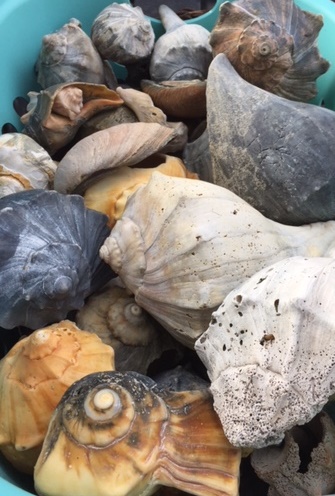
Here are some tips about when, where, and how you can find those seashells on the beaches of the Outer Banks. Pea Island, Hatteras Island, and Ocracoke Island are some of the best places to shell hunt. If you know where to look and when to look you can be rewarded with a boatload of seashells!
Types of Sea Shells On NC Coast
- Whelks: These large, spiral-shaped shells are a common sight on NC beaches. Look out for the lightning whelk, knobbed whelk, and channeled whelk. The knobbed whelk and lightning whelk are the most common on the Outer Banks. Lightning whelk shells have their opening on the left side, and knobbed whelks have their opening on the right side. These spiral shells come in a variety of sizes, from tiny to quite large. Their intricate patterns and sturdy structure make them a favorite among collectors!
- Conchs: Look for the beautiful conch shells, known for their vibrant colors and distinctive shape. The while milk conchs and Florida fighting conchs are usually found south of Hatteras. These shells often have a glossy appearance and can be quite large!
- Sand Dollars: If you’re lucky, you might stumble upon these delicate treasures while strolling along the shore. Sand dollars are flat, round, and covered in tiny spines. Their sizes can be about 1 inch to 4 inches at their widest point. They have a flower-like shape in the center of their body. Sand dollars are brittle, fragile, and white from sun-bleaching. Remember, it’s best to leave live sand dollars in their natural habitat! If you find a sand dollar that is a darker color and has fur-like growth on it, it may still be alive and should not be handled. If found alive please return it to the water.
- Olive Shells: These elongated, smooth shells are a true beauty to behold. It is one of the more common spiral shell varieties found on our coast. Long, slender, and cylindrical, these shells have a short spiral and a large but narrow opening. They measure anywhere from 1 inch to 4 inches long. Olive shells come in various shades of tan, brown, and gray.
- Scotch Bonnets: the official North Carolina state seashell! Named for their resemblance to the traditional Scottish headwear, these shells are a prized find for collectors. With their distinctive shape and intricate patterns, Scotch Bonnets are a true gem of the NC coast! Scotch Bonnets can be brown, yellow, and orange in color.
- Starfish: Starfish found on the Outer Banks have five tapered arms that radiate out from their main body. Finding a Starfish can be really exciting, but do not remove it from the water if the body feels soft or limp. This means the animal may still be alive. Once dead, starfish are dry and stiff to the touch.
- Ocean Quahog: The shells are hinged clam shells. When found on shore they are a single side, no longer hinged together. These are thick shells that have a white interior with a purple rim. These shells are a very common find along our beaches.
- Atlantic Giant Cockles: These shells are radially-ribbed hinged clam shells. When found on shore they are a single side, no longer hinged together. Atlantic Giant Cockles range in size from about a half inch to six inches at their widest part. They are usually off-white with brown and red markings. Their underside is usually smooth and pink.
- Scallops: These shells are clam shells. They come in a wide variety of colors on the Outer Banks. They are about three inches at their widest width and are radially-ribbed with “ears” sticking out slightly on either side of their base.
- Shark Eye Moon Snail: These shells are spiral-shaped with a pointed end that resembles a shark eye. They can be 5 inches at their widest point. They are smooth, spiral-shaped, spherical shells found in a variety of colors (brown to blue-gray).
- Coquinas: Small hinged clam shells that grow to be only an inch long. These can be found with both sides still together. They are typically white on both sides. The insides can have tinges of purple and yellow. Coquina Beach, located south of Nags Head, is named for these shells!
Seaglass
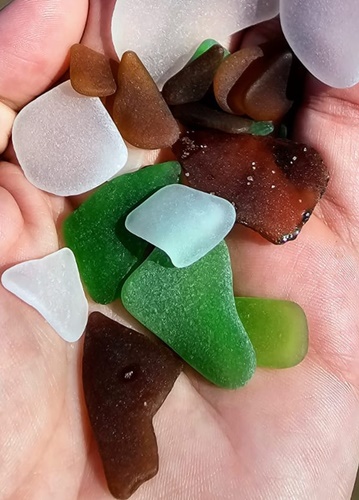
Sea glass comes from glass objects that made their way into the ocean, broke up, and eroded into small smooth pieces over time. It is glass that has ended up in a body of salt water somehow. The glass piece has been worn down by strong ocean currents, sand and debris resulting in a smooth and frosted appearance. The saltwater is harsh so it wears on the glass for many years resulting in a frosted appearance.
Sea glass can come from many sources, bottles that were thrown into the ocean, glass from very old electric poles (glass insulators) that once lined Highway 12 years ago, or even glass items that were on shipwrecks. It can take 10 to 40 years for glass to become sea glass! The most common sea glass colors that are found on the beaches of the Outer Banks are white, amber, and green.
Weather Tides And Shorelines
The weather, the ocean currents, and the shoreline are always changing. You never know where the best seashell beds will be from day to day. To find the best shellbed you may have to do some walking along the beach. If you aren’t having luck at one beach try another. There are many public beach accesses to choose from. If you have a 4-wheel drive vehicle ride down the beach until you find a shell bed. If you come across a broken whelk shell lying on the beach, stop. Look in the water near the waves breaking and see if there is a shell bed nearby covered by ocean surf. If there are broken ones on the beach then there must be more nearby in the ocean!
When- Lowtide Is Best
Outer Banks shelling is best done at low tide. The water has receded and the shells resting in the drop-off ridges are where many shells are located. Yes, some shells do just wash up on the beach, but that is not always the case. Shell beds are also easier to search through at low tide.
After a big storm, nor’easter, or hurricane are great times to go shell hunting. Make sure it is safe to go out on the beach, then grab your gear and hit the beach. Heavy surf and high winds can force many shells onto the beach. If you can beat other shell hunters out there, you can load up on finding shells.
Another great time to shell hunt is very early in the morning after a low tide. Be the first on the beach and you can pick up the shells that have washed up overnight. The early bird finds all the shells!
How To Seach For Shells
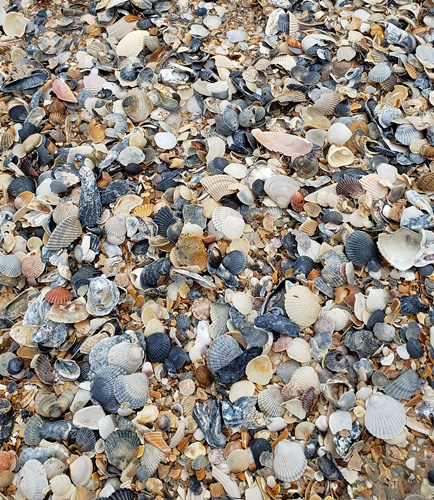
When you come across a shell bed, take your time. Scan the shells slowly. If you have to, kneel down in the bed. Look closely and carefully. Move the shells around with your feet or your hands. You can spend hours in a shell bed and be rewarded for your patience!
Equipment
I need equipment you may ask. Yes! Water shoes to protect your feet from cuts are a big help. A wide-brim hat to protect your face and neck from the sun. A beach coverup to guard against sunburn. And of course sunscreen protection. It would help if you also had something to put all those shells in. A tote bag, an over-the-shoulder body bag, or a net bag is really nice, so the sand will fall through the small openings. You can also clean the shells with a water hose while they are still in the net bag. You need something to put all the shells you find into.
Outer Banks Shelling Tours
I know of one Outer Banks shelling tour service run by Ray Stallings. He takes people and groups out to the beaches on Hatteras and Ocracoke Islands to look for shells. He knows all the good spots! You can contact/ visit his Facebook page under Ray Stallings if this might interest you. He is a National Park Service approved service provider. For more information about tours, contact OBX Beach Shuttle Services at obxshuttles@gmail.com or call (252) 908-2994.
Shelling On The Outer Banks
Remember, when collecting seashells, it’s important to be mindful of the environment. Always ensure that the shells you collect are empty and no longer home to any living creatures. Let’s preserve the beauty of our coast for generations to come!
So, next time you’re enjoying the sandy beaches of North Carolina, keep your eyes peeled for these incredible shelling types! Happy shelling, everyone!

